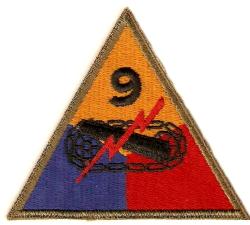
Nickname; None recorded (the Germans called it “Phantom Division”). ….. Shoulder Patch: Usual armored patch with three areas, red (FA) blue (Inf.) and yellow (Cav.), A black tank tread and cannon are crossed by red bolt of lightning. Numerals in black. ….. Training: Activated; July 15, 1942, Ft. Riley, Kans., composed largely of Old 2nd Cavalry Division personnel. Maneuvers: Louisiana, Third Army. Other stations: Camp Young, Calif., Camp Polk, La. ‘Overseas: Aug., 1944 (ETO). ….. Commanding Generals: Maj. Gen. Goeffrey Keys, July-Oct., 1942; Maj. Gen. John W. Leonard, Oct., 1942, to present. ….. Component Units: (As of Aug., 1944): 27th, 52nd and 80th Armored Infantry Battalions; 2nd, 14th and 19th Tank Battalions: 3rd, 10th and 73rd Arm. FA Battalions. Higher Command: Third Army. ….. Awards: Distinguished Unit Citation to 52nd Armored Infantry Battalion and 2nd Tank Battalion for action at Bastogne, Dec. 18-27, 1944; DUC to Combat Command “A” for action east of Bastogne in Dec., 1944. ….. Combat Highlights: Seizure of the Ludendorff Bridge at Remagen, a coup which saved thousands of American lives and undoubtedly shortened the war, was one of the 9th Armored Division’s proud accomplishments. The Division went into line in Oct., 1944, in the quiet sector along the Luxembourg-German frontier. Quiet was shattered by the Nazi winter offensive and the 9th was sent to Bastogne and other danger points to stem the tide. It was here, there and yonder quickly and by its fast moving caused the Nazis to call it the Phantom. Its combat teams were at Bastogne, St. Vith and Echternach and captured many prisoners, destroyed many more and accounted for a great deal of German armor. Combat teams defended Bastogne and split the German wedge to keep it from wheeling north into Belgium cities. Early in 1945, the 9th began a drive on the west wall aimed at the Roer river. By February the Division had smashed out into the Cologne plain and in. March electrified the Allied armies by seizure of the Ludendorff Bridge. Seizure of the bridge came in March after the 9th had reached Remagen. Brig. Gen. William H. Hoge, Combat Command “B,” saw the bridge intact, scrapped his plans for a sweep south along the Rhine and ordered his men across the bridge. Fighting their way through heavy fire, a handful of his men succeeded in reaching the east bank of the Rhine where they seized the ground and established a firm bridgehead. Pressing into the Reich in April, the 9th took Limberg, reached almost to Frankfort, captured Leipzig during May and headed into Czechoslovakia.


